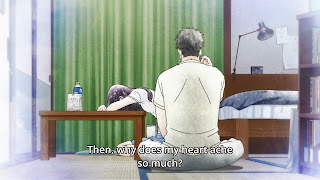After the Rain – Episode 7

Distinctly manipulated lighting and shadows, fog and smoke effects, rain, stylized use of contrast and desaturation, and a myriad of image processing – these are often used to create visual textures that can capture a mood, an atmosphere and a certain emotional tone. Visual textures definitely tell a story but often a singular one strongly befitting a scene or even an entire movie. What stood out in this episode of After the Rain is the use of visual textures as a narrative device in an almost shot by shot basis. Various visual textures were used to accentuate the characters’ emotions and to mirror the dialogue. After a tense interaction with Kondo in which he said (to Tachibana), “You know nothing about me,” the characters then faced their emotions in Kondo’s apartment. The scene started off neutral in terms of lighting, color and texture. When the two started to express their feelings more, the visual texture changed to reflect the emotional shift. The above screenshots sh...



